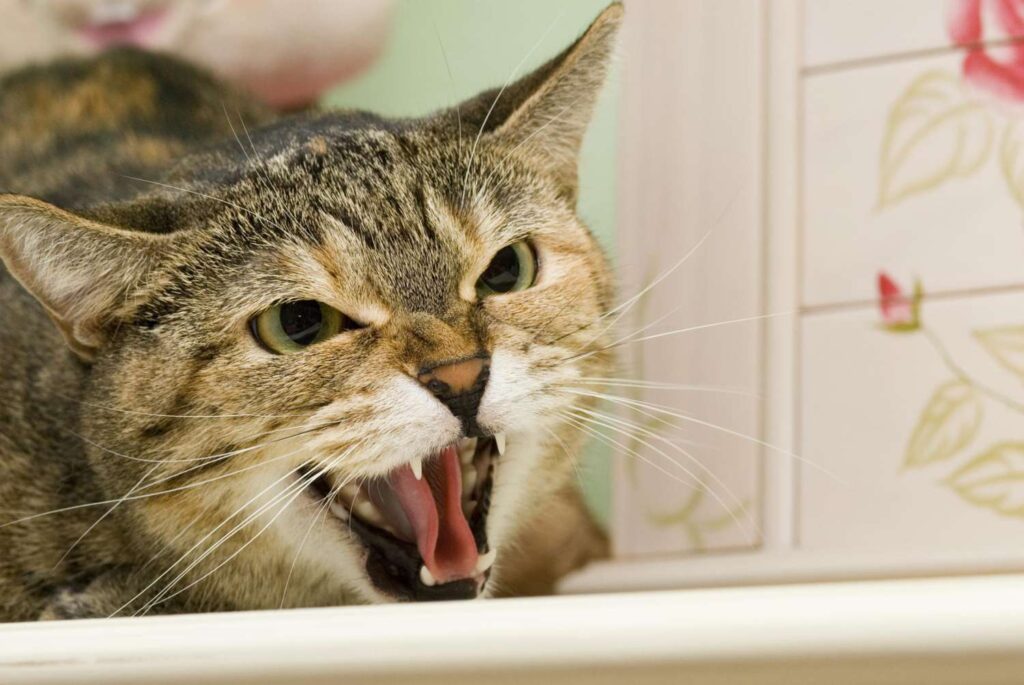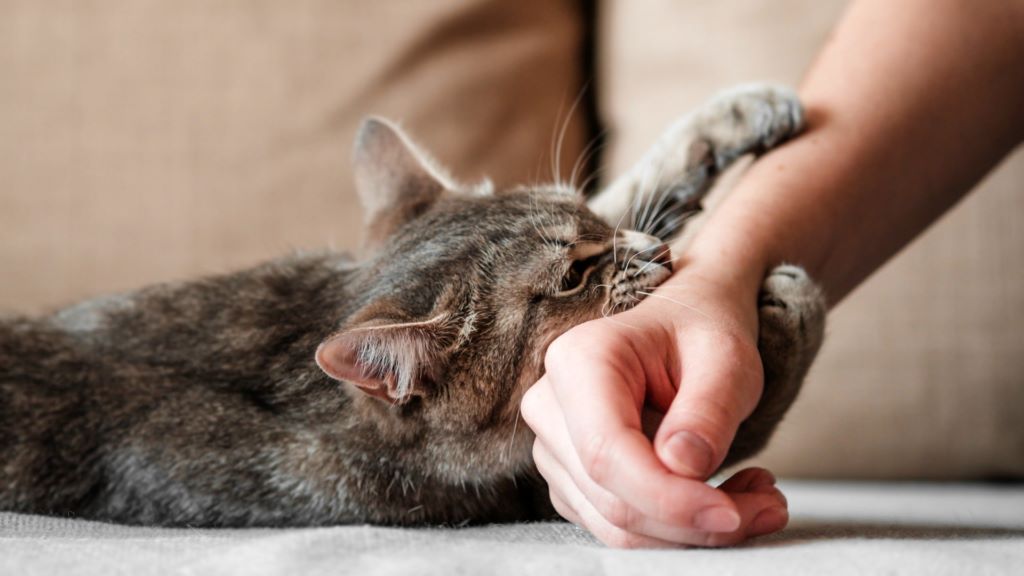6 Reasons Why Your Cat is Suddenly Aggressive

People know cats for their playful and affectionate personalities, but sometimes, cats exhibit aggressive behavior on seemingly random occasions. Whether it’s hissing, swatting, or biting, aggressive behavior in cats can be concerning for pet owners. In this article, we will discuss six reasons why your cat is suddenly aggressive and what you can do to help.
It is important to understand why your cat is suddenly aggressive. Not only is it scary or frustrating but a cat bite or scratch can easily transmit diseases. This makes cat aggression a serious matter altogether. A behaviorist is recommended for most owners in such a case. However, this article aims to help you develop a better understanding of this phenomenon first.
Understanding the Body Language

Sometimes, cats exhibit aggression without any clear cause. However, it’s important to understand that there are usually subtle changes in their body language before they act out. Recognizing these changes can help to identify why your cat is suddenly aggressive and provide warning signs for the future.
When a cat is feeling defensive, it will often take on postures that make them look smaller and more protected. This may include crouching, flattening their ears, turning away from the person, hissing, swatting, raising their hackles, or tucking their head. These postures signal fear or anxiety, which the cat directs toward a situation that you may not be aware of. It’s important to be aware that fear-based aggression can happen even if you’re not the cause of their anxiety.
On the other hand, when a cat is in an offensive mode, it will adopt postures that make them look bigger and more intimidating. These postures include: stiff legs, raised hackles, moving towards you, staring at you, upright ears, growling, and a stiff tail.
It’s crucial to avoid interacting with a cat that is exhibiting either of these postures. This is because they are likely about to move on to more damaging behavior. A cat in attack mode can act with incredible speed and aggression. Their aggressive behavior can cause significant harm in a short period of time. This is because the mouth and all four paws are involved.
Reasons Why Your Cat is Suddenly Aggressive:
Cat aggression is usually the result of several possible factors. 6 of the most important reasons why a cat may suddenly exhibit aggressive behavior are as follows:
1. Fear and Anxiety

Cats are sensitive creatures and can easily become frightened by loud noises, unfamiliar surroundings, or new people. This fear can trigger an aggressive response in some cats, as they try to protect themselves from perceived threats. If your cat seems anxious or fearful, try to provide a safe and comfortable environment by reducing stressors and offering plenty of hiding spots and hiding places.
Various factors contribute to the causes of fear aggression in cats, such as living conditions, human interactions, lack of socialization, genetic predisposition, and overall personality. Poor human-cat relationships, including previous experiences with punishment, can also contribute to the development of fear aggression in cats.
This type of aggression is usually preceded by defensive body language. That can be a crouched position, tensed muscles, flattened ears, and a tucked head. In this state, cats may try to avoid the person or object they perceive as a threat, but when they feel trapped, they may attack as a defense mechanism.
A cat exhibiting fear aggression will have its body low to the ground, ears flattened back and may bare its teeth while hissing or growling. This behavior is not an attack on the person, but instead the cat’s way of keeping them away. This is a common reason for why your cat is suddenly aggressive.
Tips to Calm the Cat:
- Reduce the chances of triggering aggressive behavior.
- Provide a food treat to the cat while they are relaxed during the triggering situation.
- Teach the cat to engage in an alternative behavior during situations that previously triggered fear.
- Medication can be used in conjunction with behavioral modification (your vet can provide guidance).
- Synthetic pheromones, such as Feliway spray or diffuser, can have a calming effect on cats and can be obtained at a veterinary clinic.
2. Pain or Illness

Pain and illness can also cause cats to become aggressive. If your cat has suddenly become more aggressive, visit the vet to rule out any underlying health issues. Common causes of pain in cats include arthritis, dental problems, and urinary tract issues.
The cat becomes aggressive as it is experiencing physical discomfort or anticipating it. This may be especially during handling if they are in pain from chronic conditions like arthritis or an injury. Past painful experiences, such as a difficult grooming session, may also lead to aggression.
Tips to Calm the Cat:
- Provide pain relief.
- Gradual desensitization to previous triggers of pain.
- Reinforce positive behavior with treats.
3. Territorial Aggression

Cats naturally defend their territory and may exhibit aggression if they perceive a threat, such as other cats, new pets, or visitors to their home. To reduce territorial aggression, make sure each cat has their own designated areas for sleeping, eating, and playing.
When dealing with territorial aggression, slow introductions or reunions are key. Confine new or returning cats to their own room with separate resources, then switch the aggressive and introduced cat in the main area for 30 minutes daily for several days.
Tips to Calm the Cat:
- Place both cats in carriers or leashes at opposite ends of a room for feeding and gradual acclimation.
- Ask your veterinarian for medication and gradually desensitize the situation.
- Use barriers like baby gates or lightweight panels to separate aggressive cats.
4. Maternal Changes

Maternal changes can be one of the strong reasons why your cat is suddenly aggressive. When a female cat is pregnant or has just given birth, her hormones change dramatically, which can make her feel threatened and more likely to become aggressive.
This is especially true if stress or danger to her kittens triggers the cat. Additionally, nursing cats can become aggressive as they attempt to protect their offspring and ensure that they have enough food and resources. This can also occur if a lactating cat is disturbed while nursing or if she perceives a threat to her kittens.
In these cases, it is essential to approach the mother cat with caution and to avoid interacting with her or her kittens until she has calmed down. If the aggression persists or becomes more severe, it may be necessary to seek veterinary help to prevent injury to the mother or her kittens.
Tips to Calm the Cat:
- Create a quiet and low-stress environment.
- Limit visitors to the household.
- Avoid contact with the mother cat and kittens if displaying aggression.
- Wait for maternal aggression to subside as the kittens mature and become more independent.
5. Redirected Aggression

Redirected aggression is a type of aggression that is caused when a cat is excited or upset about something but is unable to act on it. This type of aggression is often seen when a cat sees or smells another cat outside, and the cat becomes territorial. However, since the cat is unable to directly interact with the outside cat, it then redirects its aggression towards another cat in the household or a human.
This can result in repeated incidents of aggression and can lead to inter-cat aggression whenever the cats meet again. To prevent redirected aggression from happening repeatedly, it is important to try to remove the trigger that is causing the aggression in the first place.
Tips to Calm the Cat:
- Avoid triggers by preventing access to window sills, covering windows, or keeping other cats away.
- Don’t handle the cat if they appear aroused.
- Gradually expose the cat to the fearful stimulus to desensitize them, or use a counter-conditioning approach with food treats.
- Consider using medication in combination with behavioral modification, as advised by a veterinarian.
6. Play Aggression

Play aggression is a common type of aggression in cats, often seen in young and energetic cats who live as single pets in a household. These cats may have been taken away from their mother and siblings at an early age and have developed a tendency for rough play. Owners may contribute to this behavior by playing roughly with their kitten and rewarding the cat for biting and clawing.
During play aggression, the cat will approach the person and leap onto them without any warning growls or hisses. They may hide behind a barrier, focused intently and with their tail twitching, waiting for someone to walk by so they can attack their ankles. Hands dangling over the armrest of a chair can also be a favorite target. The cat will not show signs of fear or avoidance of the person, but rather seem to enjoy the interaction.
Tips to Calm the Cat:
- Avoid playing aggressively with the cat, and ignore any unwanted behavior so as not to reinforce it with attention. If the cat tries to play aggressively, move away from the situation and do not react.
- Use positive reinforcement training by rewarding the cat with a food treat when they are playing with their toy or when they are calm and relaxed.
- Avoid confrontational reactions such as physical punishment, or reacting to the aggression with fast movements or high-pitched vocalizations, as these may reinforce the aggression through negative reinforcement.
- Put a bell on the cat so you can hear where they are and be prepared.
- Interrupt aggressive behavior by ignoring and moving away, then redirect the behavior by tossing a toy for the cat to play with.
- Provide interesting toys and rotate their use, avoiding string toys that can cause intestinal obstructions if swallowed.
- Have daily play periods with your cat using toys to allow for playful interaction and expression of normal behavior, but without the possibility of biting or scratching.
- Teach bite and claw inhibition using positive reinforcement training by initially playing with the cat when they are calm and stopping play as soon as any pressure is applied to your skin. Over time, reduce the amount of pressure that you tolerate.
- Interact with the cat in an appropriate manner to satisfy its need for social contact and to teach them to interact appropriately with you.
In conclusion, understanding why your cat is suddenly aggressive is key to helping them overcome it. If your cat is exhibiting aggressive behavior, it’s important to seek professional help to determine the underlying cause and find the best course of action. Whether it’s through environmental changes, medical intervention, or behavior modification, with the right help, you can help your cat overcome aggressive behavior and live a happy, healthy life.


